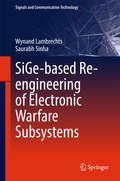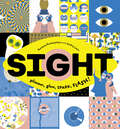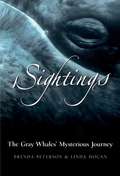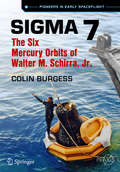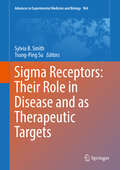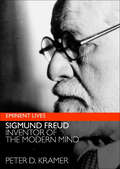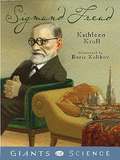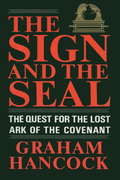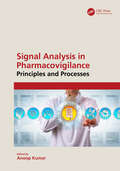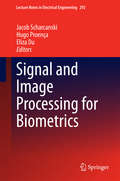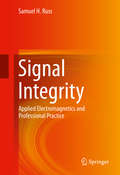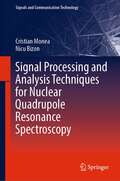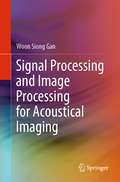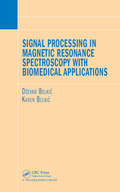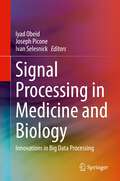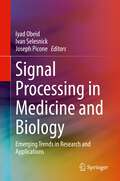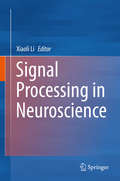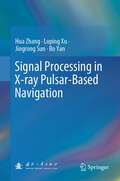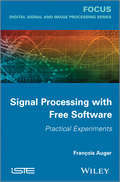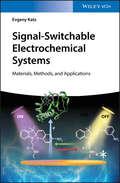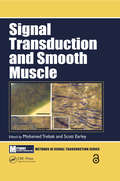- Table View
- List View
SiGe-based Re-engineering of Electronic Warfare Subsystems
by Wynand Lambrechts Saurabh SinhaThis book provides readers a thorough understanding of the applicability of new-generation silicon-germanium (SiGe) electronic subsystems for electronic warfare and defensive countermeasures in military contexts. It explains in detail the theoretical and technical background, and addresses all aspects of the integration of SiGe as an enabling technology for maritime, land, and airborne / spaceborne electronic warfare, including research, design, development, and implementation. The coverage is supported by mathematical derivations, informative illustrations, practical examples, and case studies. While SiGe technology provides speed, performance, and price advantages in many markets, to date only limited information has been available on its use in electronic warfare systems, especially in developing nations. Addressing that need, this book offers essential engineering guidelines that especially focus on the speed and reliability of current-generation SiGe circuits and highlight emerging innovations that help to ensure the sustainable long-term integration of SiGe into electronic warfare systems.
Sight: Glimmer, Glow, SPARK, FLASH!
by Romana Romanyshyn Andriy LesivSight is a groundbreaking introduction to our vivid, sensory world.This nonfiction book is an immediately accessible, science-intensive illumination of an endlessly fascinating subject: sight.Packed with facts about all aspects of vision, this is a sensitive exploration of how sight essentially impacts our everyday lives.• At once instructional and inspirational• Features stunning visual sophistication• Filled with compelling infographicsSight is a stunning, multifaceted visual exploration of one of our critical senses.This gorgeous book goes beyond the facts—it encourages not only scientific exploration, but philosophical reflection on the very nature of vision. • Resonates year-round as a go-to gift for birthdays, holidays, and more• Perfect for curious children ages 8 to 12 years old• Equal parts educational and visual, this makes a great pick for schools, librarians, teachers, grandparents, and parents.• You'll love this book if you love books like Nature Anatomy: The Curious Parts and Pieces of the Natural by Julia Rothman, Animalium: Welcome to the Museum by Jenny Broom, and Eye to Eye: How Animals See the World by Steve Jenkins.
Sightings: The Gray Whales' Mysterious Journey
by Linda Hogan Brenda PetersonTraces the lives of gray whales during their migrations between Alaska and Mexico, from their summer feeding grounds in the Bering Sea to winter birthing lagoons in Baja, examining their rich history including the conflict between their hunters and environmental protectors.
Sigma 7
by Colin BurgessColin Burgess offers a comprehensive yet personal look at the 1962 orbital mission of Wally Schirra aboard the spacecraft Sigma 7, the first book about this popular pioneering astronaut which explores his entire life and accomplishments. This continues the Pioneers in Early Spaceflight series, the volumes of which form an excellent record of Project Mercury's pioneering early phase of the Space Age. Schirra's pre-NASA life is examined, as well as his training as a NASA astronaut and for his Mercury MA-8 flight. The 6-orbit flight of Sigma 7 is fully covered from its origins through to the spacecraft's safe recovery from the ocean after a highly successful Mercury mission. Schirra's participation on the Gemini 6 and Apollo 7 missions is also told, but in brief, and the book also relates his post-NASA life and activities through to his passing in 2007. The Mercury Seven occupy a unique spot in the history of human spaceflight, and Schirra is at last given his due as one of the contributing astronauts in this painstakingly researched book.
Sigma Receptors: Their Role in Disease and as Therapeutic Targets
by Sylvia B. Smith Tsung-Ping SuOriginally confused with opioid receptors and then orphan receptors with no biological function, Sigma Receptors are now recognized as relevant to many degenerative diseases with remarkable potential as therapeutic targets. In this text, new information about the structure of sigma 1 receptor, its binding sites are provided as well as its expression in many cell types. It’s putative role in degenerative neuronal diseases including amyotrophic lateral sclerosis, Alzheimer’s disease, Parkinson’s disease, Huntington’s disease, pain, drug addiction and locomotor activity. Their roles in possible treatments for blinding retinal diseases emphasize the tremendous far-reaching potential for ligands for these receptors. Exciting breakthroughs in this dynamic field in the last decade are reported herein, which will guide future investigators in determining the full potential of this unique, yet abundantly expressed protein.
Sigmund Freud: Inventor of the Modern Mind (Eminent Lives)
by Peter D. KramerReferred to as "the father of psychoanalysis," Sigmund Freud is credited with championing the "talking cure" and charting the human unconscious. Both revered and reviled, he was a brilliant innovator but also a man of troubling contradictions—sometimes tyrannical, often misrepresenting the course and outcome of his treatments to make the "facts" match his theories. Peter D. Kramer—acclaimed author, practicing psychiatrist, and a leading national authority on mental health—offers a stunning new take on this controversial figure. Kramer is at once critical and sympathetic, presenting Freud the mythmaker, the storyteller, the writer whose books will survive among the classics of our literature, and the genius who transformed the way we see ourselves.
Sigmund Freud
by Kathleen KrullSteven de Selby has a hangover. Bright lights, loud noise, and lots of exercise are the last thing he wants. But that's exactly what he gets when someone starts shooting at him. Steven is no stranger to death-Mr. D's his boss after all-but when a dead girl saves him from sharing her fate, he finds himself on the wrong end of the barrel. His job is to guide the restless dead to the underworld but now his clients are his own colleagues, friends, and family. Mr. D's gone missing and with no one in charge, the dead start to rise, the living are hunted, and the whole city teeters on the brink of a regional apocalypse-unless Steven can shake his hangover, not fall for the dead girl, and find out what happened to his boss- that is, Death himself.
Sigmund Freud and the Jewish Mystical Tradition
by David BakanIn this pioneering work, David Bakan challenges the popular view of Freud as an entirely secular intellectual, schooled in modern culture rather than Jewish traditions. Bakan contends that the father of psychology was profoundly influenced by mystic lore about which he appeared to know very little -- and which represents the antithesis of scientific method.This work is based on the premise that Freudian psychoanalytic theory is largely rooted in the Jewish religion, particularly the mysticism of the kabbala. In a fascinating interpretation of the blend of personality and cultural history, Bakan explains how Freud's Jewish heritage contributed, either consciously or unconsciously, to his psychological theories. The author employs Freud's own distinction between being a Jew and the acceptance of Jewish doctrine to demonstrate the effect of Jewish mysticism in the formation of Freud's technical genius.With its focus on the ways in which Freud was and was not Jewish, this study offers a model example of the problem of Jewish identity -- as embodied by one of the giants of modern science, who professed to be both "infidel" and "Jew."
The Sign and the Seal
by Graham HancockThe fact of the Lost Ark of the Covenant is one of the grant historical mysteries of all time. To believers, the Ark is the legendary vesel holding the stone tablets of the Ten Commandments. The Bible contains hundreds of references to the Ark's power to level mountains, destroy armies, and lay waste to cities. The Ark itself, however, mysteriously disappears from recorded history sometime after the building of the Temple of Solomon. After ten years of searching through the dusty archives of Europe and the Middle East, as well as braving the real-life dangers of a bloody civil war in Ethiopia, Graham Hancock has succeeded where scores of others have failed. This intrepid journalist has tracked down the true story behind the myths and legends -- revealing where the Ark is today, how it got there, and why it remains hidden. Part fascinating scholarship and part entertaining adventure yarn, tying together some of the most intriguing tales of all time -- from the Knights Templar and Prester John to Parsival and the Holy Grail -- this book will appeal to anyone fascinated by the revelation of hidden truths, the discovery of secret mysteries.
Signal Analysis in Pharmacovigilance: Principles and Processes
by Anoop KumarThis book provides detailed concepts and information on principles and processes of signal analysis in pharmacovigilance along with case studies. It covers the fundamental concepts and principles of pharmacovigilance, emphasizing the need for robust signal detection and analysis methods. The book reviews the diverse array of databases and tools employed for signal detection, including electronic health records (EHRs), social media mining, claims data, and distributed data networks. In turn, the book discusses the application of molecular dynamics, molecular docking, and the use of the FDA Adverse Event Reporting System (FAERS) database in signal analysis. Toward the end, the book explores the identification, validation, and assessment of signals associated with vaccines. This book is useful for graduate, post-graduate students of pharmaceutical sciences, and scientists in pharmacology research and drug development.
Signal and Image Processing for Biometrics
by Jacob Scharcanski Hugo Proença Eliza DuThis volume offers a guide to the state of the art in the fast evolving field of biometric recognition to newcomers and experienced practitioners. It is focused on the emerging strategies to perform biometric recognition under uncontrolled data acquisition conditions. The mainstream research work in this field is presented in an organized manner, so the reader can easily follow the trends that best suits her/his interests in this growing field. The book chapters cover the recent advances in less controlled / covert data acquisition frameworks, segmentation of poor quality biometric data, biometric data quality assessment, normalization of poor quality biometric data. contactless biometric recognition strategies, biometric recognition robustness, data resolution, illumination, distance, pose, motion, occlusions, multispectral biometric recognition, multimodal biometrics, fusion at different levels, high confidence automatic surveillance.
Signal and Image Processing Techniques for the Development of Intelligent Healthcare Systems
by E. Priya V. RajinikanthThis book comprehensively reviews the various automated and semi-automated signal and image processing techniques, as well as deep-learning-based image analysis techniques, used in healthcare diagnostics.It highlights a range of data pre-processing methods used in signal processing for effective data mining in remote healthcare, and discusses pre-processing using filter techniques, noise removal, and contrast-enhanced methods for improving image quality.The book discusses the status quo of artificial intelligence in medical applications, as well as its future. Further, it offers a glimpse of feature extraction methods for reducing dimensionality and extracting discriminatory information hidden in biomedical signals. Given its scope, the book is intended for academics, researchers and practitioners interested in the latest real-world technological innovations.
Signal Integrity
by Samuel H. RussThis textbook teaches how to design working systems at very high frequencies. It is designed to introduce computer engineers to the design of extremely high speed digital systems. Combining an intuitive, physics-based approach to electromagnetics with a focus on solving realistic problems, the author presents concepts that are essential for computer and electrical engineers today. The book emphasizes an intuitive approach to electromagnetics, and then uses this foundation to show the reader how both physical phenomena can cause signals to propagate incorrectly; and how to solve commonly encountered issues. Emphasis is placed on real problems that the author has encountered in his professional career, integrating problem-solving strategies and real signal-integrity case studies throughout the presentation. Students are challenged to think about managing complex design projects and implementing successful engineering and manufacturing processes. Each chapter includes exercises to test concepts introduced.
Signal Processing and Analysis Techniques for Nuclear Quadrupole Resonance Spectroscopy (Signals and Communication Technology)
by Cristian Monea Nicu BizonThis book is about improving prohibited substances detection using the nuclear quadrupole resonance (NQR) technique at security checkpoints. The book proposes multiple signal processing and analysis techniques for improving detection of dangerous or contraband substances, such as explosives, narcotics, or toxic substances. Also, several hardware solutions are described and implemented in a custom-designed NQR spectrometer. A new approach to NQR signal detection is introduced using artificial intelligence/deep learning techniques. The book will be useful for for researchers and practitioners in the areas of electrical engineering, signal processing and analysis, applied spectroscopy, as well as for security or laboratory equipment manufacturers.
Signal Processing and Image Processing for Acoustical Imaging
by Woon Siong GanThis book discusses the applications of signal and image processing in acoustical imaging. It first describes the basic tools involved – the 2D transform, fast Fourier transform (FFT) and applications, and deconvolution – before introducing readers to higher-order statistics, wavelets, and neural networks. It also addresses the important topic of digital signal processing, focusing on the example of homomorphic signal processing. The book then details the design of digital filters and array signal processing, and lastly examines applications in image processing: image enhancement and optimization, image restoration, and image compression.
Signal Processing and Machine Learning for Biomedical Big Data
by Ervin Sejdic Tiago H. FalkWithin the healthcare domain, big data is defined as any ``high volume, high diversity biological, clinical, environmental, and lifestyle information collected from single individuals to large cohorts, in relation to their health and wellness status, at one or several time points.'' Such data is crucial because within it lies vast amounts of invaluable information that could potentially change a patient's life, opening doors to alternate therapies, drugs, and diagnostic tools. Signal Processing and Machine Learning for Biomedical Big Data thus discusses modalities; the numerous ways in which this data is captured via sensors; and various sample rates and dimensionalities. Capturing, analyzing, storing, and visualizing such massive data has required new shifts in signal processing paradigms and new ways of combining signal processing with machine learning tools. This book covers several of these aspects in two ways: firstly, through theoretical signal processing chapters where tools aimed at big data (be it biomedical or otherwise) are described; and, secondly, through application-driven chapters focusing on existing applications of signal processing and machine learning for big biomedical data. This text aimed at the curious researcher working in the field, as well as undergraduate and graduate students eager to learn how signal processing can help with big data analysis. It is the hope of Drs. Sejdic and Falk that this book will bring together signal processing and machine learning researchers to unlock existing bottlenecks within the healthcare field, thereby improving patient quality-of-life. Provides an overview of recent state-of-the-art signal processing and machine learning algorithms for biomedical big data, including applications in the neuroimaging, cardiac, retinal, genomic, sleep, patient outcome prediction, critical care, and rehabilitation domains. Provides contributed chapters from world leaders in the fields of big data and signal processing, covering topics such as data quality, data compression, statistical and graph signal processing techniques, and deep learning and their applications within the biomedical sphere. This book’s material covers how expert domain knowledge can be used to advance signal processing and machine learning for biomedical big data applications.
Signal Processing in Magnetic Resonance Spectroscopy with Biomedical Applications
by Dzevad Belkic Karen BelkicAddressing the critical need in clinical oncology for robust and stable signal processing in magnetic resonance spectroscopy (MRS), Signal Processing in Magnetic Resonance Spectroscopy with Biomedical Applications explores cutting-edge theory-based innovations for obtaining reliable quantitative information from MR signals for cancer diagnostics. By defining the natural framework of signal processing using the well-established theory of quantum physics, the book illustrates how advances in signal processing can optimize MRS. <p> The authors employ the fast Padé transform (FPT) as the unique polynomial quotient for the spectral analysis of MR time signals. They prove that residual spectra are necessary but not sufficient criteria to estimate the error invoked in quantification. Instead, they provide a more comprehensive strategy that monitors constancy of spectral parameters as one of the most reliable signatures of stability and robustness of quantification. The authors also use Froissart doublets to unequivocally distinguish between genuine and spurious resonances in both noise-free and noise-corrupted time signals, enabling the exact reconstruction of all the genuine spectral parameters. They show how the FPT resolves and quantifies tightly overlapped resonances that are abundantly seen in MR spectra generated using data from encoded time signals from the brain, breast, ovary, and prostate. <p> Written by a mathematical physicist and a clinical scientist, this book captures the multidisciplinary nature of biomedicine. It examines the remarkable ability of the FPT to unambiguously quantify isolated, tightly overlapped, and nearly confluent resonances.
Signal Processing in Medicine and Biology: Innovations in Big Data Processing
by Iyad Obeid Joseph Picone Ivan SelesnickSignal Processing in Medicine and Biology: Innovations in Big Data Processing provides an interdisciplinary look at state-of-the-art innovations in biomedical signal processing, especially as it applies to large data sets and machine learning. Chapters are presented with detailed mathematics and complete implementation specifics so that readers can completely master these techniques. The book presents tutorials and examples of successful applications and will appeal to a wide range of professionals, researchers, and students interested in applications of signal processing, medicine, and biology at the intersection between healthcare, engineering, and computer science.
Signal Processing in Medicine and Biology: Emerging Trends in Research and Applications
by Iyad Obeid Ivan Selesnick Joseph PiconeThis book covers emerging trends in signal processing research and biomedical engineering, exploring the ways in which signal processing plays a vital role in applications ranging from medical electronics to data mining of electronic medical records. Topics covered include statistical modeling of electroencephalograph data for predicting or detecting seizure, stroke, or Parkinson’s; machine learning methods and their application to biomedical problems, which is often poorly understood, even within the scientific community; signal analysis; medical imaging; and machine learning, data mining, and classification. The book features tutorials and examples of successful applications that will appeal to a wide range of professionals and researchers interested in applications of signal processing, medicine, and biology.
Signal Processing in Neuroscience
by Xiaoli LiThis book reviews cutting-edge developments in neural signalling processing (NSP), systematically introducing readers to various models and methods in the context of NSP. Neuronal Signal Processing is a comparatively new field in computer sciences and neuroscience, and is rapidly establishing itself as an important tool, one that offers an ideal opportunity to forge stronger links between experimentalists and computer scientists. This new signal-processing tool can be used in conjunction with existing computational tools to analyse neural activity, which is monitored through different sensors such as spike trains, local filed potentials and EEG. The analysis of neural activity can yield vital insights into the function of the brain. This book highlights the contribution of signal processing in the area of computational neuroscience by providing a forum for researchers in this field to share their experiences to date.
Signal Processing in X-ray Pulsar-Based Navigation
by Hua Zhang Luping Xu Jingrong Sun Bo YanThis book highlights key technologies of signal processing in pulsar-based navigation. It discusses the modeling, simulation, acquisition, and correction of relativistic effects of signals from X-ray pulsars. It demonstrates the methods of contour reconstruction and denoising, and introduces the concept and methods of the average contour. The performance of the phase measurement methods using signal contour is analyzed. The role of wavelets and bispectral methods in the denoising of pulsar signals is discussed. The measurements of pulsar signals’ arriving time are looked into from the perspective of time series. The book is intended for researchers and engineers interested in pulsar-based navigation. It is also a good reference source for senior undergraduates and postgraduate students majoring in navigation and signal processing.
Signal Processing with Free Software: Practical Experiments
by François AugerAn ideal resource for students, industrial engineers, and researchers, Signal Processing with Free Software Practical Experiments presents practical experiments in signal processing using free software. The text introduces elementary signals through elementary waveform, signal storage files and elementary operations on signals and then presents the first tools to signal analysis such as temporal and frequency characteristics leading to Time-frequency analysis. Non-parametric spectral analysis is also discussed as well as signal processing through sampling, resampling, quantification, and analog and digital filtering. Table of Contents: 1. Generation of Elementary Signals. Generation of Elementary Waveform. – Elementary Operations on the Signals. – Format of Signal Storage Files. 2. First tools of Signal Analysis. Measurement of Temporal and Frequency Characteristics of a Signal. Time-Frequency Analysis of a Signal. 3. Non-parametric Spectral Analysis. 4. Signal Processing. Sampling. – Resampling. – Quantification. – “Analog” Filtering. Digital Filtering
Signal-Switchable Electrochemical Systems: Materials, Methods, and Applications
by Evgeny KatzA guide to the biological control over electronic systems that lead the way to wearable electronics and improved drug delivery In recent years, this area of electrochemical systems has developed rapidly and achieved significant progress. Signal-Switchable Electrochemical Systems offers an overview to the wide-variety of switchable electrochemical systems and modified electrodes. The author—a noted researcher and expert on the topic—summarizes research efforts of many groups in a range of universities and countries. The book explores various types of external signals that are able to modify electrode interfaces, for example electrical potential, magnetic field, light, as well as chemical and biochemical inputs. Multifunctional properties of the modified interfaces allow their responses to complex combinations of external signals. These are integrated with unconventional biomolecular computing systems logically processing multiple biochemical signals. This approach allows the biological control over electronic systems. The text explores the applications in different areas, including unconventional computing, biofuel cells and signal-triggered molecular release in electrochemical systems. This important guide: Provides an overview to the biological control over electronic systems and examines the key applications in biomedicine, electrochemical energy conversion and signal-processing Offers an important text written by a highly cited researcher and pioneer in the field Contains a summary of research efforts of an international panel of scholars representing various universities and countries Presents a groundbreaking book that provides an introduction to this interdisciplinary field Written for scientists working with electrochemical systems and applications with signal-responsive materials, Signal-Switchable Electrochemical Systems presents an overview of the multidisciplinary field of adaptable signal-controlled electrochemical systems and processes and highlights their key aspects and future perspectives.
Signal Transduction: Pathways, Mechanisms and Diseases
by Ari SitaramayyaThe book was adapted from graduate courses on signal transduction taught by the editor, where the need for a good overview of recent developments became apparent. Given the wide range of research topics in signaling, a selection was made that not only reflects the current research interest, but also anticipates those areas that will continue to be of interest over the next several years. The health-relatedness of research was a major criterion for selection, as can be seen in the list of topics covered, such as G protein coupled receptors, growth factors, nuclear receptors, reactive oxygen and nitrogen species, the cell cycle and cancer. The emphasis is on areas of signaling research with direct clinical significance. Another field covered, one rarely highlighted in signal transduction books, is that of signaling platforms, which has been emerging as a significant research area relevant to cellular metabolism, cell proliferation, differentiation, apoptosis, neurodegenerative diseases, and cancer.
Signal Transduction and Smooth Muscle (Methods in Signal Transduction Series)
by Mohamed Trebak and Scott EarleyAll hollow organs, such as blood vessels, the gastrointestinal tract, airways, male and female reproductive systems, and the urinary bladder are primarily composed of smooth muscle. Such organs regulate flow, propulsion and mixing of luminal contents and storage by the contraction and relaxation of smooth muscle cells. Smooth muscle cells respond to numerous inputs, including pressure, shear stress, intrinsic and extrinsic innervation, hormones and other circulating molecules, as well as autocrine and paracrine factors. This book is a review of smooth muscle cell regulation in the cardiovascular, reproductive, GI, and other organ systems with emphasis on calcium and receptor signaling. Key selling features: Focuses on smooth muscles of different types Describes ion channel signaling mechanisms Reviews calcium and receptor signaling Includes novel, cutting-edge methodologies Summarizes studies of mice with genetically encoding sensors in smooth muscle Chapter 9 of this book is freely available as a downloadable Open Access PDF at http://www.taylorfrancis.com under a Creative Commons Attribution (CC-BY) 4.0 license.
